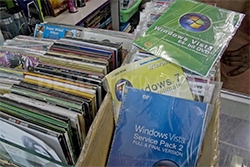Asia-Pacific businesses suffer most from software piracy
 >> Microsoft study tests pirated software
>> Microsoft study tests pirated software
The cost of dealing with the impact of malware-induced cyber-attacks for enterprises is predicted to be $114 billion globally in 2013, while in Asia Pacific, the study forecasts spending will reach $39 billion. The regional number increases to a staggering $129 billion if the cost of data loss is taken into consideration.
Consumers also share the burden and cost, with the IDC study showing that as a result of these infections consumers worldwide will spend 1.5 billion hours and $22 billion identifying, repairing and recovering from the impact of malware.
The study analysed 270 websites and peer-to-peer (P2P) networks, 108 software downloads, and 155 CDs or DVDs. IDC also interviewed 2,077 consumers and 258 IT managers or chief information officers from Brazil, China, Germany, India, Mexico, Poland, Russia, Thailand, the United Kingdom and the United States.
Researchers found that of the counterfeit software that does not come with the computer, 45 per cent is downloaded from the internet. Of this, 78 per cent is downloaded from websites or P2P networks and includes some type of spyware, while 36 percent contained Trojans and adware.
“The cybercrime reality is that counterfeiters are tampering with the software code and lacing it with malware,” said Jeff Bullwinkel, director of legal and corporate affairs for Asia Pacific and Japan at Microsoft. “Some of this malware records a person’s every keystroke -- allowing cybercriminals to steal a victim’s personal and financial information -- or remotely switches on an infected computer’s microphone and video camera, giving cybercriminals eyes and ears in boardrooms and living rooms. The best way to secure yourself and your property from these malware threats when you buy a computer is to demand genuine software.”
The IDC study, titled “The Dangerous World of Counterfeit and Pirated Software,” was released today as part of Play It Safe Day, http://www.playfairday.com/Microsoft’s global initiative to bring awareness to issues related to software piracy.
“Our research is unequivocal: Inherent dangers lurk for consumers and businesses that take a chance on counterfeit software,” said John Gantz, chief researcher at IDC. “Some people choose counterfeit to save money, but this ‘ride-along’ malware ends up putting a financial and emotional strain on both the enterprise and casual computer users alike.”
The following are among the highlights from the consumer survey:
• 62 percent of respondents knew someone who had used counterfeit software and experienced security issues
• 55 percent of the time, counterfeit software slowed their PCs, and the software had to be uninstalled
• 50 percent of respondents noted that their greatest concern with using counterfeit software was data loss
• 30 percent were most concerned with identity theft
Embedding counterfeit software with dangerous malware is a new method for criminals to prey on computer users who are unaware of the potential danger.
A separate study conducted by Microsoft in Southeast Asia in February 2013 examined name-brand PCs with pirated software installed and counterfeit software DVDs, uncovering an average malware infection rate of 69 per cent. In that study, Microsoft’s testing of 282 computers and DVDs from Indonesia, Malaysia, Thailand, Philippines and Vietnam revealed 5,601 instances and 1,131 unique strains of malware and virus infections. It further revealed pirated copies of Windows embedded with malware spread across numerous well-known PC brands, including: Acer, Asus, Dell, HP, Lenovo and Samsung. Microsoft believes that neither the counterfeit images nor the malware originated from—or were installed by—the individual PC manufacturers. Rather, the computers were likely shipped with non-Windows operating systems, which were later replaced by individuals in the downstream supply chain or retail channel who deal in the illegal duplication and distribution of pirated software.
The IDC white paper also explored the surprising level of end-user software installations made on corporate computers, exposing another method for the introduction of unsecure software into the workplace ecosystem. In Asia Pacific, although 56 percent of IT managers acknowledge that it happens, 74 percent of workers admit they install personal software onto employer-owned computers. What is alarming is that respondents told IDC that only 12 percent of the software they installed on their work computers was problem-free. 66 percent of IT managers agree that user-installed software increases an organization’s security risks. For many in the enterprise, user-installed software may be a blind spot in ensuring a secure network.
Customers are encouraged to visit www.microsoft.com/security to learn about malware and ensure their machine is not infected; if malware is present, the site offers tools to remove the infection. Customers shopping for a new computer are encouraged to buy from a reputable source to ensure they are receiving genuine Microsoft software.
What the stars mean:
★ Poor ★ ★ Promising ★★★ Good ★★★★ Very good ★★★★★ Exceptional
Related Contents
Latest News
More News
- Businesses ramp up production as year-end orders surge (December 30, 2025 | 10:05)
- Vietjet chairwoman awarded Labour Hero title (December 29, 2025 | 13:06)
- How to unlock ESG value through green innovation (December 29, 2025 | 10:03)
- AI reshapes media and advertising industry (December 29, 2025 | 08:33)
- FPT and GELEX sign deal to develop blockchain tech for global markets (December 29, 2025 | 08:29)
- Vietnam’s GDP forecast to grow by 9 per cent in 2026 (December 29, 2025 | 08:29)
- Women entrepreneurs are key to Vietnam’s economic growth (December 29, 2025 | 08:00)
- Vietnam's top 500 value-creating enterprises announced (December 27, 2025 | 08:00)
- The PAN Group shaping a better future with ESG strategy (December 26, 2025 | 09:00)
- Masan Consumer officially lists on HSX, marking the next phase of value creation (December 25, 2025 | 13:20)

 Tag:
Tag:





















 Mobile Version
Mobile Version